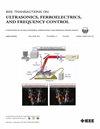Generalized Multiphysical Fields Coupled Model of SAW Resonators: From Methodology to Applications
IF 3
2区 工程技术
Q1 ACOUSTICS
IEEE transactions on ultrasonics, ferroelectrics, and frequency control
Pub Date : 2024-12-24
DOI:10.1109/TUFFC.2024.3522109
引用次数: 0
Abstract
Multiphysics modeling is crucial in surface acoustic wave (SAW) resonators. Existing coupling methods primarily focus on the displacement and electrical potential originating from the piezoelectric effect. As SAW technology advances, novel interaction mechanisms introduce new challenges in multiphysics modeling. In order to address these complexities, simulations must incorporate additional physical fields, such as semiconducting, thermal, and other fields. This study presents a comprehensive methodology for multiphysics coupling in SAW resonators, categorizing the couplings into direct and indirect types based on whether they occur through constitutive relations or through initial and boundary conditions. For direct coupling, we extend the intrinsic piezoelectric effect to piezoelectric and semiconducting coupling via constitutive laws as an illustrative example. Specifically, we simulate the electromechanical (EM)-carrier coupling in a multilayered SAW resonator, providing insights into the parasitic surface conduction (PSC) effect. In contrast, indirect coupling involves physical fields with frequencies significantly lower than that of SAW. As a representative case, we analyze the bidirectional interaction between the thermal field and SAW, where the bias field is simplified into initial and boundary conditions. A thermoelastic model using the sequential algorithm is proposed to predict the temperature coefficient of frequency (TCF) and the self-heating effect in multilayered SAW structures. Simulation results demonstrate excellent agreement with experimental data. Based on these findings, we propose optimization strategies to enhance the performance of SAW resonators.SAW谐振器的广义多物理场耦合模型:从方法论到应用
多物理场建模在表面声波谐振器中是至关重要的。现有的耦合方法主要关注压电效应产生的位移和电势。随着声表面波技术的发展,新的相互作用机制给多物理场建模带来了新的挑战。为了解决这些复杂性,模拟必须包含额外的物理领域,如半导体、热学和其他领域。本研究提出了SAW谐振器中多物理场耦合的综合方法,根据耦合是通过本构关系发生的,还是通过初始条件和边界条件发生的,将耦合分为直接型和间接型。对于直接耦合,我们通过本构定律将本征压电效应扩展到压电和半导体耦合。具体来说,我们模拟了多层SAW谐振器中的机电(EM)-载流子耦合,为寄生表面传导(PSC)效应提供了见解。相比之下,间接耦合涉及的物理场频率明显低于声呐。作为典型案例,我们分析了热场与声表面波的双向相互作用,其中偏置场被简化为初始条件和边界条件。提出了一种基于序贯算法的热弹性模型来预测多层SAW结构的频率温度系数和自热效应。仿真结果与实验数据吻合良好。基于这些发现,我们提出了优化策略来提高声表面波谐振器的性能。
本文章由计算机程序翻译,如有差异,请以英文原文为准。
求助全文
约1分钟内获得全文
求助全文
来源期刊
CiteScore
7.70
自引率
16.70%
发文量
583
审稿时长
4.5 months
期刊介绍:
IEEE Transactions on Ultrasonics, Ferroelectrics and Frequency Control includes the theory, technology, materials, and applications relating to: (1) the generation, transmission, and detection of ultrasonic waves and related phenomena; (2) medical ultrasound, including hyperthermia, bioeffects, tissue characterization and imaging; (3) ferroelectric, piezoelectric, and piezomagnetic materials, including crystals, polycrystalline solids, films, polymers, and composites; (4) frequency control, timing and time distribution, including crystal oscillators and other means of classical frequency control, and atomic, molecular and laser frequency control standards. Areas of interest range from fundamental studies to the design and/or applications of devices and systems.

 求助内容:
求助内容: 应助结果提醒方式:
应助结果提醒方式:


